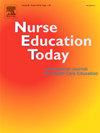探讨护理学生在临床实践中的患者安全学习经验:一项利用SLERT工具的定性研究。
IF 4.2
2区 医学
Q1 EDUCATION, SCIENTIFIC DISCIPLINES
引用次数: 0
摘要
背景:患者安全是一个全球关注的问题。以实践为基础的护理教育是培养安全知识、技能和实践的关键。“SLIPPS”学习事件记录工具(SLERT)以多种欧洲语言提供,旨在帮助医疗保健专业的学生记录、反思并从真实的患者安全事件中学习。探索SLERT在不同文化和医疗环境中的翻译和使用,以及在波斯语等广泛使用的语言是很重要的。目的:将SLERT翻译成波斯语,并调查伊朗护生使用该工具来反思临床实践中遇到的患者安全相关事件。设计:采用SLERT,然后进行两阶段定性描述性研究。背景:伊朗西北部的阿达比尔。研究对象:通过有目的的抽样方法招募护理专业学生63名。方法:通过填写SLERT的电子版或纸质版来收集数据。参与者被要求以讲故事的方式大声表达自己的想法和反思(第一阶段)。使用定性内容分析,在此期间,随访访谈有助于澄清歧义(阶段2)。结果:完成SLERT电子报告23份,纸质报告40份。学生报告了8次未遂事件,7次危险事件,10次不良事件和38次良好实践事件。“从事件中加强学习”的核心主题包括四个主要类别:考虑事件分类(严重性/主题)、认识事件结果(消极事件结果和积极学习);识别可能的原因和解决方案(个人/组织因素);识别影响学习的因素(环境、教育者和教育方法的影响)。结论:本研究的参与者发现SLERT在促进和支持对真实患者安全事件的反思方面是一个有用的工具。一个原始的发现是关于使用SLERT如何无意中促进了事件分类的学习。学生们不仅思考事件的前因和结果,还考虑如何对事件进行分类,并分析自己的学习经历和结果。本文章由计算机程序翻译,如有差异,请以英文原文为准。
Exploring nursing students' patient safety learning experiences during clinical practice: A qualitative study utilizing the SLERT tool
Background
Patient safety is a global concern. Practice-based nursing education is pivotal in fostering safety knowledge, skills, and practice. The ‘SLIPPS’ Learning Event Recording Tool (SLERT), available in multiple European languages, was developed to aid healthcare students document, reflect on, and learn from, real patient-safety events. It is important to explore SLERT translation and use in diverse cultural and healthcare contexts, and in widely spoken languages such as Persian.
Objectives
To translate the SLERT into Persian and investigate Iranian nursing students' use of the tool to reflect on patient safety related events experienced during clinical practice.
Design
SLERT adaption followed by a 2-stage qualitative descriptive study.
Settings
Ardabil in northwest Iran.
Participants
Nursing students (n = 63) recruited through purposeful sampling.
Methods
Data were collected through accompanied completion of an electronic or paper version of the SLERT. Participants were prompted to express thoughts and reflections aloud in a storytelling manner (stage 1). Qualitative content analysis was used, during which follow-up interviews helped clarify ambiguities (stage 2).
Results
Twenty-three electronic and 40 paper SLERT reports were completed. Students reported 8 near-misses, 7 hazards, 10 adverse-events, and 38 good-practice episodes. A core theme “Enhanced Learning from Events” was developed comprising four main-categories: Consideration of event classification (severity/topic), Recognition of event outcomes (negative event outcomes and positive learning); Identification of possible causes and solutions (individual/organizational factors); Identification of factors influencing learning (impact of environment, educator & educational approaches).
Conclusion
Participants in this study found the SLERT a useful tool in promoting and supporting reflection on real patient safety events. An original finding regards how SLERT use had the inadvertent benefit of promoting learning about event classification. Students went beyond reflecting solely on the antecedents and outcomes of the event, to consider how events are classified and to analyze their own learning experiences and outcomes.
求助全文
通过发布文献求助,成功后即可免费获取论文全文。
去求助
来源期刊

Nurse Education Today
医学-护理
CiteScore
6.90
自引率
12.80%
发文量
349
审稿时长
58 days
期刊介绍:
Nurse Education Today is the leading international journal providing a forum for the publication of high quality original research, review and debate in the discussion of nursing, midwifery and interprofessional health care education, publishing papers which contribute to the advancement of educational theory and pedagogy that support the evidence-based practice for educationalists worldwide. The journal stimulates and values critical scholarly debate on issues that have strategic relevance for leaders of health care education.
The journal publishes the highest quality scholarly contributions reflecting the diversity of people, health and education systems worldwide, by publishing research that employs rigorous methodology as well as by publishing papers that highlight the theoretical underpinnings of education and systems globally. The journal will publish papers that show depth, rigour, originality and high standards of presentation, in particular, work that is original, analytical and constructively critical of both previous work and current initiatives.
Authors are invited to submit original research, systematic and scholarly reviews, and critical papers which will stimulate debate on research, policy, theory or philosophy of nursing and related health care education, and which will meet and develop the journal''s high academic and ethical standards.
 求助内容:
求助内容: 应助结果提醒方式:
应助结果提醒方式:


